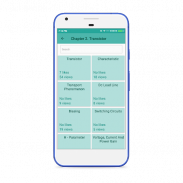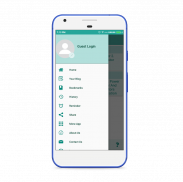






Electronics - I

คำอธิบายของElectronics - I
It is swipe base design for bio technology students to learn basics of electronics . It almost cover important topics with their graphics chapter wise which are given below
Chapter 1. Semi conductor diodes
1. Introduction to circuit elements R,L,C and their characteristics
2. current sources controlled
3. uncontrolled sources KCL and KVL analysis
4. Nodal & mesh analysis
5. analysis of magnetically coupled circuits
6. Transients in RL Circuits
7. Transients in RC Circuits
8. Concept of phasor & vector
9. Network topology
10. concept of Network graph
11. Tree and Tree branch & link
12. Incidence matrix
13. dual networks
14. Dot convention
15. tuned circuits
16. Series & parallel resonance
Chapter 2. Transistor
1. Transistor
2. Characteristic
3. Transport phenomenon
4. DC load line
5. Biasing
6. Switching Circuits
7. h - Parameter
8. Voltage, Current and Power Gain
9. JEFT
10. Transfer characteristics MOSFET
11. Types of MOSFET
12. RC Coupled Amplifier
13. Noise in BJT
Chapter 3. Feedback amplifiers & oscillators
1. Negative and positive feedback
2. Gain and sensitivity
3. BANDWIDTH
4. Types of feedback
5. Oscillator
6. Types of oscillator and application
7. UJT characteristics and application
8. Multi vibrator circuits and their applications.
Chapter 4. Power amplifier and Regulators Classification
1. Types of power amplifier circuits
2. Amplifier Applications
3. Complementary symmetry circuits
4. Push pull amplifier
5. Crossover Distortion
6. Biasing of power amplifier
7. Heat sink
8. Voltage regulator
9. Current initiating circuits
10. Adjustable Voltage Regulator
11. 3 terminal positive series regulators
12. Dual IC power supply SMPS
Chapter 5. Design and application of electronic circuits
1. Design and application of passive filter
2. Designing of clipper and clamper
3. Circuit
4. Designing of power amplifiers
5. Feedback amplifier
6. Oscillators and DC coupled amplifier circuits
7. Designing of multivibrators circuits.
</div> <div jsname="WJz9Hc" style="display:none">มันเป็นรูดออกแบบฐานสำหรับนักเรียนเทคโนโลยีชีวภาพการเรียนรู้พื้นฐานของอุปกรณ์อิเล็กทรอนิกส์ มันเกือบจะครอบคลุมหัวข้อที่สำคัญกับบทกราฟิกของพวกเขาฉลาดที่จะได้รับดังนี้
บทที่ 1 ไดโอดกึ่งตัวนำ
1. รู้เบื้องต้นเกี่ยวกับองค์ประกอบวงจร R, L, C และลักษณะของพวกเขา
2. แหล่งที่มาควบคุมในปัจจุบัน
3. แหล่งที่มาที่ไม่สามารถควบคุม KCL KVL และการวิเคราะห์
4. การวิเคราะห์ปมและตาข่าย
5. การวิเคราะห์วงจรคู่แม่เหล็ก
6. Transients ในวงจร RL
7. Transients ในวงจร RC
8. แนวคิดของเฟสเซอร์และเวกเตอร์
9. โครงสร้างเครือข่าย
10. แนวคิดของกราฟเครือข่าย
11. ต้นไม้และสาขาต้นไม้และการเชื่อมโยง
12. เมทริกซ์อุบัติการณ์
13. เครือข่ายคู่
14. การประชุม Dot
15. วงจรปรับ
16. ซีรีส์และเสียงสะท้อนขนาน
บทที่ 2 ทรานซิสเตอร์
1. ทรานซิสเตอร์
2. ลักษณะ
3. ปรากฏการณ์ขนส่ง
4. สายโหลดซี
5. biasing
6. สลับวงจร
7 ชั่วโมง - พารามิเตอร์
8. แรงดันไฟฟ้าในปัจจุบันและการได้รับพลังงาน
9. JEFT
10. ลักษณะโอน MOSFET
11. ประเภทของมอสเฟต
12. RC คู่แอมป์
13. เสียงรบกวนใน BJT
บทที่ 3 แอมป์และข้อเสนอแนะ oscillators
1. ข้อเสนอแนะในเชิงบวกและเชิงลบ
2. กำไรและความไว
3. แบนด์วิธ
4. ประเภทของข้อเสนอแนะ
5. Oscillator
6. ประเภทของ oscillator และการประยุกต์ใช้
7. ลักษณะ UJT และการประยุกต์ใช้
8. วงจรสั่นหลายและการประยุกต์ใช้
บทที่ 4 เครื่องขยายเสียงพลังงานและการควบคุมการจัดหมวดหมู่
1. ประเภทของวงจรขยายอำนาจ
2. การประยุกต์ใช้เครื่องขยายเสียง
3. วงจรสมมาตรเสริม
4. กดดึงเครื่องขยายเสียง
5. การบิดเบือนครอสโอเวอร์
6. การให้น้ำหนักของเครื่องขยายเสียงพลัง
7. อ่างล้างจานร้อน
8. ควบคุมแรงดันไฟฟ้า
9. วงจร initiating ปัจจุบัน
10. ควบคุมแรงดันไฟฟ้าที่สามารถปรับได้
11. 3 ขั้วชุดหน่วยงานกำกับดูแลในเชิงบวก
12. แหล่งจ่ายไฟแบบ Dual IC SMPS
บทที่ 5 การออกแบบและการประยุกต์ใช้วงจรอิเล็กทรอนิกส์
1. การออกแบบและการประยุกต์ใช้ตัวกรองเรื่อย ๆ
2. การออกแบบและตัด Clamper
3. วงจร
4. การออกแบบขยายอำนาจ
5. เครื่องขยายเสียงตอบรับ
6. Oscillators และ DC คู่วงจรขยาย
7. การออกแบบวงจร multivibrators</div> <div class="show-more-end">


























